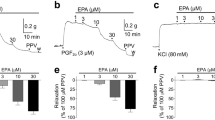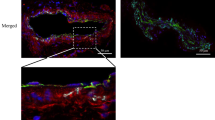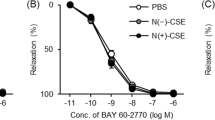Abstract
In most arterial beds a significant endothelium-dependent dilation to various stimuli persists even after inhibition of nitric oxide synthase and cyclo-oxygenase. This dilator response is preceded by an endothelium-dependent hyperpolarization of vascular smooth muscle cells, which is sensitive to a combination of the calcium-dependent potassium-channel inhibitors charybdotoxin and apamin, and is assumed to be mediated by an unidentified endothelium-derived hyperpolarizing factor (EDHF)1,2. Here we show that the induction of cytochrome P450 (CYP) 2C8/34 in native porcine coronary artery endothelial cells by β-naphthoflavone enhances the formation of 11,12-epoxyeicosatrienoic acid, as well as EDHF-mediated hyperpolarization and relaxation. Transfection of coronary arteries with CYP 2C8/34 antisense oligonucleotides results in decreased levels of CYP 2C and attenuates EDHF-mediated vascular responses. Thus, a CYP-epoxygenase product is an essential component of EDHF-mediated relaxation in the porcine coronary artery, and CYP 2C8/34 fulfils the criteria for the coronary EDHF synthase.
This is a preview of subscription content, access via your institution
Access options
Subscribe to this journal
Receive 51 print issues and online access
$199.00 per year
only $3.90 per issue
Buy this article
- Purchase on Springer Link
- Instant access to full article PDF
Prices may be subject to local taxes which are calculated during checkout




Similar content being viewed by others
References
Rubanyi,G. M. & Vanhoutte,P. M. Nature of endothelium-derived relaxing factor: are there two relaxing mediators? Circ. Res. 61, SII-61–SII-67 (1987).
Chen,G., Suzuki,H. & Weston,A. H. Acetylcholine releases endothelium-derived hyperpolarizing factor and EDRF from rat blood vessels. Br. J. Pharmacol. 95, 1165–1174 (1988).
Quilley,J., Fulton,D. & McGiff,J. C. Hyperpolarizing factors. Biochem. Pharmacol. 54, 1059–1070 (1997).
Miura,H. & Gutterman,D. D. Human coronary arteriolar dilation to arachidonic acid depends on cytochrome P-450 monoxygenase and Ca2+-activated K+ channels. Circ. Res. 83, 501–507 (1998).
Hecker,M., Bara,A. T., Bauersachs,J. & Busse,R. Characterization of endothelium-derived hyperpolarizing factor as a cytochrome P450-derived arachidonic acid metabolite in mammals. J. Physiol. (Lond.) 481, 407–414 (1994).
Popp,R. et al. A transferable, β-naphthoflavone-inducible, hyperpolarizing factor is synthesized by native and cultured porcine coronary endothelial cells. J. Physiol. (Lond.) 497, 699–709 (1996).
Rosolowsky,M. & Campbell,W. B. Role of PGI2 and epoxyeicosatrienic acids in relaxation of bovine coronary arteries to arachidonic acid. Am. J. Physiol. 264, H327–H335 (1993).
Pinto,A., Abraham,N. G. & Mullane,K. M. Arachidonic acid-induced endothelial-dependent relaxations of canine coronary arteries: contribution of a cytochrome P-450 dependent pathway. J. Pharmacol. Exp. Ther. 240, 856–882 (1987).
Oltman,C. L., Weintraub,N. L., VanRollins,M. & Dellsperger,K. C. Epoxyeicosatrienoic acids and dihydroxyeicosatrienoic acids are potent vasodilators in the canine coronary microcirculation. Circ. Res. 83, 932–939 (1998).
Fulton,D., Mahboubi,K., McGiff,J. C. & Quilley,J. Cytochrome P450-dependent effects of bradykinin in the rat heart. Br. J. Pharmacol. 114, 99–102 (1995).
Bauersachs,J., Hecker,M. & Busse,R. Display of the characteristics of endothelium-derived hyperpolarizing factor by a cytochrome P450-derived arachidonic acid metabolite in the coronary microcirculation. Br. J. Pharmacol. 113, 1548–1553 (1994).
Campbell,W. B., Gebremedhin,D., Pratt,P. F. & Harder,D. R. Identification of epoxyeicosatrienoic acids as endothelium-derived hyperpolarizing factors. Circ. Res. 78, 415–423 (1996).
Komori,K. & Vanhoutte,P. M. Endothelium-derived hyperpolarizing factor. Blood Vessels 27, 238–245 (1990).
Alvarez,J., Montero,M. & García-Sancho,J. Cytochrome P450 may link intracellular Ca2+ stores with plasma membrane Ca2+ influx. Biochem. J. 274, 193–197 (1991).
Alvarez,J., Montero,M. & García-Sancho,J. High affinity inhibition of Ca2+-dependent K+ channels by cytochrome P-450 inhibitors. J. Biol. Chem. 267, 11789–11793 (1992).
Guengerich,F. P. Characterization of human cytochrome P450 enzymes. FASEB J. 6, 745–748 (1992).
Mancy,A. et al. Interaction of sulfaphenazole derivatives with human liver cytochromes P450 2C: molecular origin of the specific inhibitory effects of sulfaphenazole on CYP 2C9 and consequences for the substrate binding site topology of CYP 2C9. Biochemistry 35, 16205–16212 (1996).
Kiss,L. et al. Simultaneous analysis of 4- and 5-series lipoxygenase and cytochrome P450 products from different biological sources by reversed-phase high-performance liquid chromatographic technique. Anal. Biochem. 261, 16–28 (1998).
Edwards,G. et al. K+ is an endothelium-derived hyperpolarizing factor in rat arteries. Nature 396, 269–272 (1998).
Pritchard, K. A. Jr, Wong,P. & Stemerman,M. B. Atherogenic concentrations of low density lipoprotein enhance endothelial cell generation of epoxyeicosatrienoic acid products. Am. J. Pathol. 136, 1381–1391 (1990).
Puntarulo,S. & Cederbaum,A. I. Production of reactive oxygen species by microsomes enriched in specific human cytochrome P450 enzymes. Free Radical Biol. Med. 24, 1324–1330 (1998).
Bauersachs,J. et al. Nitric oxide attenuates the release of endothelium-derived hyperpolarizing factor. Circulation 94, 3341–3347 (1996).
Acknowledgements
We thank I. Winter, M. Stächele, N. Hinsch and S. Hauk for expert technical assistance. This work was supported by the Deutsche Forschungsgemeinschaft and Institut de Recherches Internationales Servier.
Author information
Authors and Affiliations
Corresponding author
Rights and permissions
About this article
Cite this article
Fisslthaler, B., Popp, R., Kiss, L. et al. Cytochrome P450 2C is an EDHF synthase in coronary arteries. Nature 401, 493–497 (1999). https://doi.org/10.1038/46816
Received:
Accepted:
Issue Date:
DOI: https://doi.org/10.1038/46816
This article is cited by
-
E-cigarette effects on vascular function in animals and humans
Pflügers Archiv - European Journal of Physiology (2023)
-
Cyp2c44 epoxygenase-derived epoxyeicosatrienoic acids in vascular smooth muscle cells elicit vasoconstriction of the murine ophthalmic artery
Scientific Reports (2021)
-
Targeting arachidonic acid–related metabolites in COVID-19 patients: potential use of drug-loaded nanoparticles
Emergent Materials (2021)
-
Adenosine A2A receptor and vascular response: role of soluble epoxide hydrolase, adenosine A1 receptor and angiotensin-II
Molecular and Cellular Biochemistry (2021)
-
Identification and local manipulation of bone marrow vasculature during intravital imaging
Scientific Reports (2020)
Comments
By submitting a comment you agree to abide by our Terms and Community Guidelines. If you find something abusive or that does not comply with our terms or guidelines please flag it as inappropriate.



